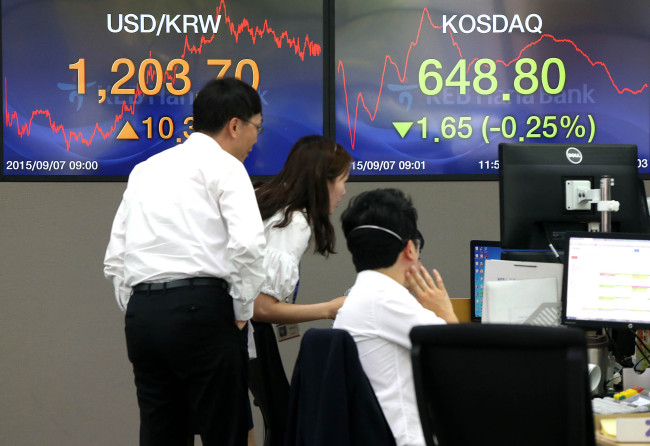South Korea’s currency further weakened Monday ahead of the interest rate-setting meeting of the Federal Open Market Committee, slated for Sept. 16-17 in Washington, D.C.
Amid the growing investor sentiment toward non-risky assets, the U.S. dollar and Japanese yen showed stronger position against the Korean won.
The dollar rose by 10.8 won from a trading session before to close at 1,204.2. The won fell to its cheapest versus the greenback in more than five years.

The Japanese currency climbed 8.52 won to close at 1,008.6 won per 100 yen.
The yen traded at between 890 won and 935 won during the first half after falling below the 1,000 won mark in October 2014. But the yen appears to have stopped its record slide from July in the wake of robust earnings by Japanese exporters and an increase in private consumption.
The won also lost ground against the euro, which closed at 1,340.34 won, up 12.28 won from a session before.
Foreigners maintained their heavy seller positon on the main bourse, net selling for the 23rd consecutive session since Aug. 5.
The benchmark KOSPI stayed below the 1,900 mark, down 2.82 points, or 0.15 percent to close at 1,883.22.
Amid the selling streak of foreign investors, the Korean bourse posted the highest in more than three years in the index volatility.
Foreign investors, which net sold 4.5 trillion won ($3.74 billion) worth over the past month, are expected to further dump stocks until the “quadruple witching day,” which falls on Sept. 10.
The quadruple witching day is the maturation date of four major derivatives, including futures and options, which could invite great fluctuation in the index.
A main factor, which would determine the direction of the KOSPI, is whether the FOMC will institute a rate hike in the next week’s meeting.
According to the Korea Exchange, the KOSPI’s volatility -- based on monthly fluctuations -- came to 1.65 percent as of Sept. 4, marking the highest since it peaked at 1.65 percent in November 2011.
The secondary KOSDAQ was worse than the main bourse, with its volatility posting its highest in four years. Its fluctuation index reached 3.21 percent over the past month, its highest since it touched 3.49 in August 2011.
“Amid uncertainty involving the U.S. move to raise the key rate and Chinese economic slowdown, more investors have been taking a wait-and-see attitude,” said a bourse official.
The daily trading volume on the average on the main bourse stood at 5.79 trillion won in July, down 1 trillion won from 6.79 trillion won a month earlier. It further dropped to below 5 trillion won in early August to stay at 4.78 trillion won.
Analysts say that the local stock market has greatly been affected by the Shanghai bourse, which plunged since early July.
After peaking at 5,166.35 on June 12, the Shanghai Stock Exchange Composite Index has remained below the 3,200 mark over the past few trading sessions.
By Kim Yon-se (kys@heraldcorp.com)


















